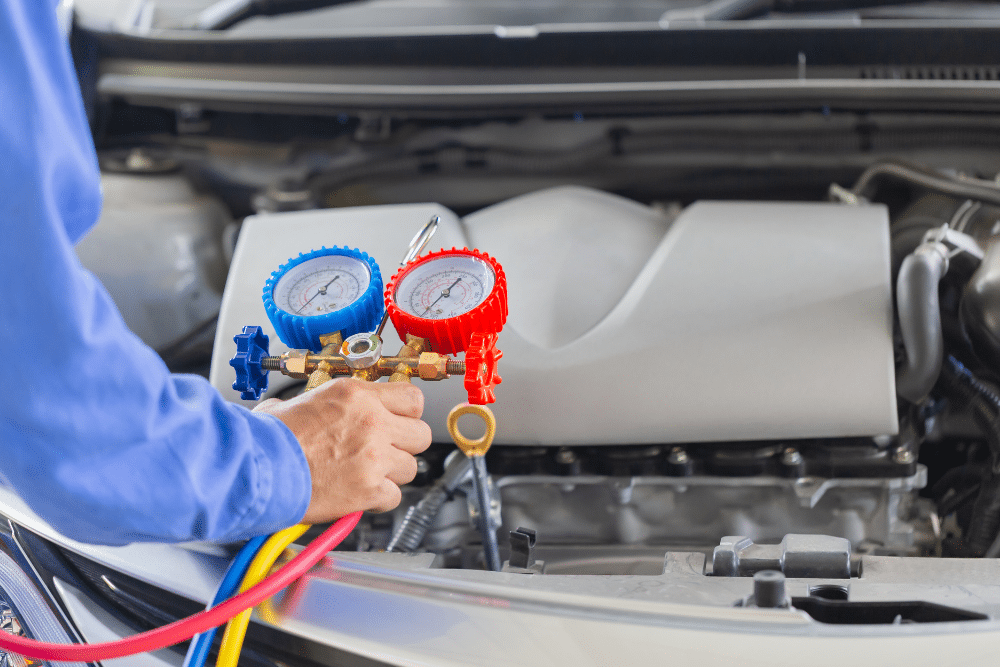A well-functioning A/C system is essential not just for comfort but also for visibility, focus, and overall driving safety, especially during Ohio’s warm, humid summers. When the air blowing from your vents isn’t as cold as it should be, or stops cooling altogether, many drivers wonder: Why is my car’s A/C not working properly? In most cases, the answer traces back to a refrigerant leak, one of the most common issues affecting modern vehicle air conditioning systems. Leaks can start small and go unnoticed until the damage becomes more expensive or the system stops functioning altogether.
In this blog, we’ll explain the top causes of refrigerant leaks in today’s vehicles, from worn seals and corroded condensers to damaged service ports and more. You’ll also learn how to spot the early warning signs, how these leaks are diagnosed, and why it’s important not to delay repairs. Whether you drive a daily commuter or a family SUV, the insights here will help you stay cool and avoid major A/C failures. If you’re looking for trusted advice and repair solutions, this guide lays it all out clearly, backed by the experienced team at Springboro Automotive.
Why Refrigerant Leaks Matter
Your vehicle’s A/C system relies on refrigerant to remove heat and moisture from the air. When that refrigerant leaks even a little, it affects performance and can lead to more serious issues.
Here’s what can happen when refrigerant levels drop:
- You get warm air instead of cold. The system can’t cool properly without enough refrigerant.
- Your defrost system might stop working effectively. Without proper airflow and dehumidification, fogged windows take longer to clear.
- Your compressor could overwork and fail prematurely. Low refrigerant puts stress on the compressor, which depends on it for lubrication.
Left unchecked, a minor leak can reduce comfort, increase repair costs, and even create unsafe driving conditions due to poor visibility.
Common Causes of Refrigerant Leaks in Today’s Vehicles
1. Worn Hoses and Seals
Rubber hoses and O-ring seals can dry out, shrink, or crack over time due to heat and age. Once compromised, they allow refrigerant to slowly escape.
Fix: We inspect and pressure-test these components during A/C service and replace any worn parts with high-quality OEM-grade materials.
2. Corroded Condenser or Evaporator
Exposure to moisture, road salt, and debris can cause tiny pinholes in the condenser or evaporator, leading to gradual refrigerant loss.
Fix: Using UV dye and electronic sniffers, we pinpoint even the smallest leaks and replace damaged parts as needed.
3. Damage from Debris or Impact
Since the A/C condenser is located near the front of the vehicle, it’s vulnerable to damage from rocks, curbs, and collisions that can cause leaks.
Fix: If your A/C stops suddenly, we perform a pressure test to identify and repair impact-related damage early.
4. Leaking Schrader Valves or Service Ports
These access points can develop leaks as their internal seals wear out, something often overlooked during routine checks.
Fix: We test every service port and replace faulty valves and caps during diagnosis.
5. Compressor Seal Wear
The compressor’s shaft seal can wear out with use, allowing refrigerant to escape while the system is running.
Fix: We confirm the issue with pressure and dye testing, then replace the compressor with a warranted unit if needed.
How We Diagnose A/C Leaks at Springboro Automotive
A/C leaks can be tricky. Some are obvious, while others are hidden deep within the system. That’s why accurate diagnosis matters. At Springboro Automotive, our ASE-certified technicians use a combination of tools and techniques to pinpoint leaks quickly and precisely.
Here’s how we get it done:
- UV dye testing: A fluorescent dye helps us visually spot leaks under UV light, especially around seals and fittings.
- Electronic sniffers: These tools detect even the smallest refrigerant leaks that might otherwise go unnoticed.
- Pressurized inspections: We examine the system while it’s running to identify signs of wear, oil residue, or damage.
- Temperature and pressure checks: Abnormal readings help us confirm leak sources and assess overall system health.
We work on both R134a and R1234yf systems, using the latest equipment to ensure safe, accurate testing and recharging. Whether your vehicle is a few years old or brand new, our process is built to catch issues early and get your A/C back to full strength.
What You Might Notice First
Refrigerant leaks often start small, which means the symptoms can creep up gradually. Catching these early warning signs can save you from more extensive and expensive repairs down the road.
Here are some of the most common indicators that your vehicle may have a refrigerant leak:
- The air isn’t as cold as it used to be: You may find that the system blows cool air at best, but never truly cold, even with the A/C turned up.
- It takes longer to cool the cabin: If your vehicle used to cool down quickly but now struggles to keep up, low refrigerant levels may be to blame.
- Strange hissing noises from the dash or engine bay: These sounds can indicate pressure escaping through a small leak, especially right after shutting off the engine.
- Oily residue on A/C components: Refrigerant carries oil through the system, so leaks often leave behind a greasy or oily film around fittings, hoses, or the condenser.
- A/C compressor cycles on and off rapidly: Known as “short cycling,” this is a sign that your system is struggling to maintain pressure, often due to low refrigerant.
If you notice any combination of these symptoms, don’t wait for a full system failure. A quick inspection can often catch the issue before it leads to a costly compressor or component replacement.
Can You Drive with a Refrigerant Leak?
You can drive with a refrigerant leak, but it’s not recommended. Low refrigerant levels mean your A/C won’t cool effectively, and worse, they can cause your compressor to overwork and overheat. Since the compressor relies on refrigerant for both cooling and lubrication, running the system at low can lead to major damage.
What could be a quick, affordable fix can quickly escalate into a full system failure if ignored. A minor leak might cost under $150 to repair, but waiting too long could turn it into a $1,000+ job. If your A/C isn’t performing like it should, it’s best to get it checked before the damage grows.
Why Trust Springboro Automotive with Your A/C Repairs?
- Founded in 1994, with a reputation built on honesty and doing it right the first time
- NAPA 36/36 Nationwide Warranty for peace of mind
- State-of-the-art diagnostics using Snap-On, Autel, and dye testing equipment
- R1234yf-capable, keeping your late-model vehicle covered
- A friendly, highly trained team that cares about your comfort and safety
We don’t do cookie-cutter work, and we never push repairs you don’t need. Just clear answers, accurate diagnostics, and high-quality parts that last.
FAQs About Car A/C Refrigerant Leaks
How do I know if my car has a refrigerant leak?
Common signs include warm air from the vents, slow cabin cooling, hissing noises, and the A/C compressor turning on and off rapidly. If you’re in the Springboro, OH area and notice these symptoms, it’s a good idea to schedule a professional auto A/C leak diagnosis.
Can a car A/C refrigerant leak be fixed, or do I need to replace the whole system?
Most refrigerant leaks can be repaired by replacing the affected seals, hoses, or components. There’s no need to replace the entire system unless the compressor or condenser is damaged. At Springboro Automotive, we focus on accurate diagnostics to avoid unnecessary repairs.
How much does it cost to fix a car A/C refrigerant leak?
Repair costs vary depending on the source of the leak. Minor issues like service port valves can be under $150, while more complex repairs involving the evaporator or compressor may cost more. We provide upfront estimates at our Springboro A/C repair shop so there are no surprises.
Is it safe to drive with a leaking car A/C system in Ohio’s summer heat?
While it’s safe in the short term, driving with a car A/C refrigerant leak can cause your compressor to fail due to a lack of lubrication. That’s why we recommend early diagnosis, especially before peak summer temperatures hit.
Is R1234yf refrigerant more prone to leaks than R134a?
Both can leak for similar reasons, but R1234yf systems require specialized equipment to handle safely. We’re fully equipped to diagnose and recharge both.
Can’t I just recharge my car’s A/C system with a DIY kit from the store?
We strongly recommend against it.
Many of the do-it-yourself kits contain stop leaks and sealers, which can cause damage to the vehicle’s A/C system. Shops also have to charge more when there is this contaminant in the system because it will damage their professional equipment. Also, most of these do-it-yourself kits only have a low side pressure gauge, and you cannot truly get an accurate reading of how much refrigerant is in the system by doing that.
A/C systems should be professionally serviced to prevent damage and higher costs to the consumer.
Don’t Sweat It This Summer – Schedule Your A/C Check Today
If you suspect a refrigerant leak, don’t wait for your A/C to quit entirely. Catching the problem early can save you from bigger, more expensive repairs and help keep your drives cool and comfortable.
At Springboro Automotive, our certified team will inspect your system, explain what’s going on, and get your A/C working like it should. No guesswork. No upsells. Just honest, reliable service. Visit us at 216 Hiawatha Trail, Springboro, OH 45066, call 937-746-7999, or request an appointment online today.


